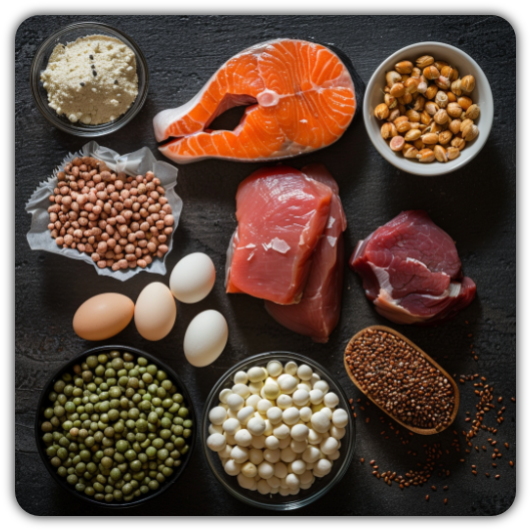Reaching Your Protein Goals: What Makes Animal & Plant Proteins Different

We now know that protein is crucial for building and repairing muscle, but when it comes to muscle protein synthesis (MPS), the engine behind muscle growth, there's a debate: animal protein vs. plant protein. Let's break down the differences and how to fuel your health and fitness goals.
Animal Protein: The Amino Acid Advantage
Animal sources like meat, fish, poultry, eggs, and dairy are considered complete proteins, containing all nine essential amino acids (EAAs) your body can't produce on its own. One key player is leucine, which acts like a trigger for MPS. Animal proteins are also generally more bioavailable, meaning your body can absorb a higher percentage of the amino acids. This translates to a more efficient MPS response.
Plant Power: It's All About Variety
Plant proteins like beans, lentils, tofu, and nuts aren't naturally endowed with all 9 essential amino acids and have antinutrients that can interfere with absorption and utilization. However, that doesn't mean they're off the muscle-building menu and play an important role in a nutrient dense and well rounded diet. By combining different plant proteins throughout the day, you can create a complete amino acid profile. Think rice and beans, almond butter on whole-wheat bread, or a protein smoothie with pea protein and hemp seeds.
Additionally, when focusing on macronutrients and calories, obtaining enough plant based complete proteins generally comes at a higher caloric cost than consuming animal protein. Example: 1 cup of quinoa equals 153 calories with 8 grams of protein and 26 grams carbohydrates versus 3 ounces of chicken breast at 101 calories with 19 grams of protein and 0 grams of carbohydrates. These are things to consider when tracking macro and caloric goals.
The Great Debate: Does it Really Matter?
While animal protein has an edge in MPS stimulation, research shows that consuming enough total protein, regardless of source, is key for muscle growth, especially when combined with resistance training.
How Much Protein Should I Eat?
Aim for your desired body weight in kilograms and multiply that by 1.5.
Ex: 150# divide by 2.2 = 68.18 kg x 1.5 = 102 grams of protein daily goal
If you have been consuming far less protein per meal, work towards 30 grams slowly over time to allow your digestion to adjust or supplement a digestive enzyme to aid in digestion and absorption.
Do My Protein Goals Change if I Am Healing from an Injury?
Yes, you require more protein to help maintain and preserve your muscle mass and bone density during inactive times. Aim for your desired body weight in kilograms and multiply that by 1.6-2.5
Ex: 150# divide by 2.2 = 68.18 kg x 1.6 = 109 grams to 170 grams of protein as a daily goal
What Should I Look for in a Protein Powder?
- Animal Protein: For top quality, choose clean ingredients and grass-fed whey protein isolate.
- Plant Protein: Plant proteins are typically low in one or more essential amino acids.
- Soy protein isolate: A complete protein and high in branch chain aminos acids (BCAAs) to support muscle strength and growth. Quality can be poor with GMO soy, so look for clean, non-GMO products.
- Pea protein is high in leucine, which increases muscle growth and stimulates the body to make muscle protein but lacks in methionine.
- Hemp and pumpkin seed have leucine, but lack lysine.
- Supplementing with other foods or taking a vegan supplement of the 9 essential amino acids like The Perfect Aminos can help you achieve MPS.
Here's the Takeaway:
- Both animal and plant proteins can fuel muscle growth.
- Animal protein offers a complete amino acid profile, are more bioavailable, and have a lower carb and caloric impact.
- Plant proteins require strategic combining to create a complete amino acid profile or require supplementation.
- As with any dietary recommendation, consider what feels right for you and notice how you feel (digestion, energy, muscle mass, etc) to decide what works best for you.
- Protein helps you feel more satiated and can decreases your cravings for unhealthy foods.
- Focus on eating 30 grams of protein per meal and a snack to reach your total daily protein intake to ensure you will stimulate muscle protein synthesis.





